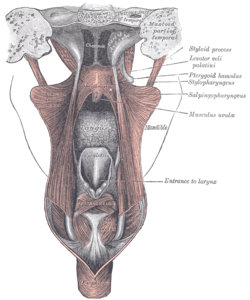Posterior nasal apertures
| Posterior nasal apertures | |
|---|---|

Lateral wall of nasal cavity.
|
|

Dissection of the muscles of the palate from behind. (Choanae visible at center top.)
|
|
| Details | |
| Identifiers | |
| Latin | Apertura nasalis posterior |
| Dorlands /Elsevier |
c_28/12234217 |
| TA | A06.1.02.003 |
| FMA | 76585 |
|
Anatomical terminology
[]
|
|
The posterior nasal apertures or internal nostrils are the openings found at the posterior (back part) of the nasal passage between the nasal cavity and the throat in tetrapods with secondary palates, including humans and other mammals (as well as crocodilians and most skinks).
In animals with secondary palates, they allow breathing when the mouth is closed. They are also known as the choanae (singular choana) (from Greek χοάνη "funnel"). In tetrapods without secondary palates their function relates primarily to olfaction (sense of smell).
The choanae are separated into two parts by the vomer.
It is the opening between the nasal cavity and the nasopharynx.
It is therefore not a structure but a space bounded as follows:
The term is a latinization from the Greek "choanē" meaning funnel.
Early bony fishes (~420 mya) had two pair of nostrils, one pair for incoming water (known as the anterior or incurrent nostrils), and a second pair for outgoing water (the posterior or excurrent nostrils), with the olfactory apparatus (for sense of smell) in between. In the first tetrapodomorphs (~415 mya) the excurrent nostrils migrated to the edge of the mouth, occupying a position between the maxillary and premaxillary bones, directly below the lateral rostral (a bone that vanished in early tetrapods).
In all but the most basal (primitive) tetrapodomorphs, the excurrent nostrils have migrated from the edge of the mouth to the interior of the mouth. In tetrapods that lack a secondary palate (basal tetrapods and amphibians), the choanae are located forward in the roof of the mouth, just inside the upper jaw. These internal nasal passages evolved while the vertebrates still lived in water. In animals with complete secondary palates (mammals, crocodilians, most skinks) the space between the primary and secondary palates contain the nasal passages, with the choanae located above the posterior end of the secondary palate.
In animals with partial secondary palates (most birds reptiles) the median choanal slit separates the two halves of the posterior half of the palate, connecting the nasal cavity with the buccal cavity (mouth) and the pharynx (throat).
...
Wikipedia
